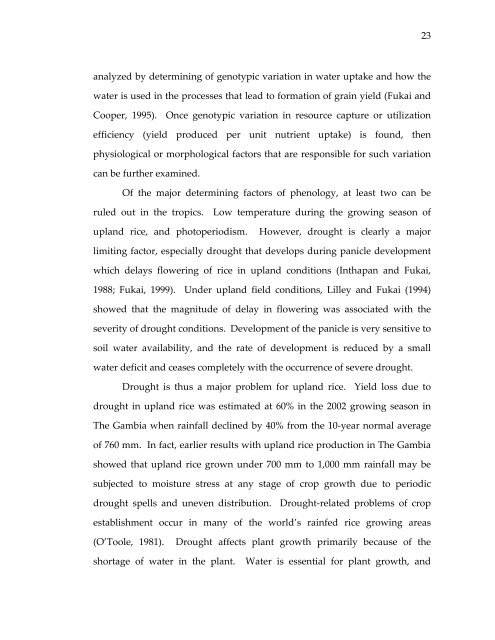Management of rice production systems to increase productivity
Management of rice production systems to increase productivity
Management of rice production systems to increase productivity
Create successful ePaper yourself
Turn your PDF publications into a flip-book with our unique Google optimized e-Paper software.
analyzed by determining <strong>of</strong> genotypic variation in water uptake and how the<br />
water is used in the processes that lead <strong>to</strong> formation <strong>of</strong> grain yield (Fukai and<br />
Cooper, 1995). Once genotypic variation in resource capture or utilization<br />
efficiency (yield produced per unit nutrient uptake) is found, then<br />
physiological or morphological fac<strong>to</strong>rs that are responsible for such variation<br />
can be further examined.<br />
Of the major determining fac<strong>to</strong>rs <strong>of</strong> phenology, at least two can be<br />
ruled out in the tropics. Low temperature during the growing season <strong>of</strong><br />
upland <strong>rice</strong>, and pho<strong>to</strong>periodism. However, drought is clearly a major<br />
limiting fac<strong>to</strong>r, especially drought that develops during panicle development<br />
which delays flowering <strong>of</strong> <strong>rice</strong> in upland conditions (Inthapan and Fukai,<br />
1988; Fukai, 1999). Under upland field conditions, Lilley and Fukai (1994)<br />
showed that the magnitude <strong>of</strong> delay in flowering was associated with the<br />
severity <strong>of</strong> drought conditions. Development <strong>of</strong> the panicle is very sensitive <strong>to</strong><br />
soil water availability, and the rate <strong>of</strong> development is reduced by a small<br />
water deficit and ceases completely with the occurrence <strong>of</strong> severe drought.<br />
Drought is thus a major problem for upland <strong>rice</strong>. Yield loss due <strong>to</strong><br />
drought in upland <strong>rice</strong> was estimated at 60% in the 2002 growing season in<br />
The Gambia when rainfall declined by 40% from the 10‐year normal average<br />
<strong>of</strong> 760 mm. In fact, earlier results with upland <strong>rice</strong> <strong>production</strong> in The Gambia<br />
showed that upland <strong>rice</strong> grown under 700 mm <strong>to</strong> 1,000 mm rainfall may be<br />
subjected <strong>to</strong> moisture stress at any stage <strong>of</strong> crop growth due <strong>to</strong> periodic<br />
drought spells and uneven distribution. Drought‐related problems <strong>of</strong> crop<br />
establishment occur in many <strong>of</strong> the world’s rainfed <strong>rice</strong> growing areas<br />
(O’Toole, 1981). Drought affects plant growth primarily because <strong>of</strong> the<br />
shortage <strong>of</strong> water in the plant. Water is essential for plant growth, and<br />
23
















